|
|

|
|
Author
|
Topic: Space Cover 436: A Requiem for Cassini
|
micropooz
Member Posts: 1578
From: Washington, DC, USA
Registered: Apr 2003
|
 posted 10-01-2017 06:07 AM
posted 10-01-2017 06:07 AM
   
Space Cover of the Week, Week 436 (October 1, 2017) Space Cover #436: A Requiem for CassiniIn late 2000 the Cassini probe passed through the Jupiter system on its way to Saturn. Doing so allowed Cassini to do some joint observations of Jupiter with the Galileo probe that was already in orbit around Jupiter, and gave Cassini a big gravity slingshot to help propel it on out to Saturn. The cover above was postmarked in Pasadena, CA (home of JPL) on December 30, 2000, when Cassini was closest to Jupiter. The cachet is the JPL Stamp Club's printed cachet for Cassini. With all the coverage of Cassini's final dive into Saturn's atmosphere in the last couple weeks, I hatched this grand plan that the Space Cover of the Week (SCOTW) gang ought to do a requiem for the late Cassini Mission. After all, there were 20 years-worth of covers for it and everyone could chip in with their favorite. The rest of the SCOTW gang agreed and let me go out-of-sequence to kick it off with my favorite Cassini cover. Then I went to my box of interplanetary covers to sort through my myriad Cassini covers to find a favorite. Well, long story short, my myriad consisted of one cover, the one above! I guess I'd always thought that with Cassini going on and on and on, that I'd pick up some covers later, and never did... So, the rest of you probably have much more in the way of covers to commemorate the epic scientific mission of Cassini. Let's post your favorites here! And as always, if you can't host a cover image, just email it to me and I'll be glad to host it so you can post it here. |
Antoni RIGO
Member Posts: 216
From: Palma de Mallorca, Is. Baleares - SPAIN
Registered: Aug 2013
|
 posted 10-01-2017 09:22 AM
posted 10-01-2017 09:22 AM
   
As I think most of the Cassini covers come from NASA side, and Cassini-Huygens was a joint NASA-ESA mission, I would like to share a cover from ESA side.  The above pictured cover was cancelled in Villafranca del Castillo (Madrid), Spain, on Jul 1st, 2004 where one of main ESA tracking stations is located and commemorates the insertion of Cassini-Huygens spaceprobe in Saturn orbit. This cover bears a thermographic Spanish sticker (with face value of 0,27 Euro, weak after years) and with a poor postmark, but is shown here because it was a difficult cover to obtain at this time. |
Bob M
Member Posts: 1784
From: Atlanta-area, GA USA
Registered: Aug 2000
|
 posted 10-03-2017 09:54 AM
posted 10-03-2017 09:54 AM
   
On September 15th, while entering Saturn's atmosphere at 76,000 mph, the Cassini spacecraft disintegrated in Saturn's atmosphere, one month shy of its 20th anniversary in space.During its 13 years at Saturn, Cassini observed the birth of mini-moonlets in Saturn's rings and spotted massive hurricanes on the planet's poles. It also found six new moons and a number of faint rings. Among its most dazzling discoveries was the presence of hydrocarbon lakes and seas on Saturn's largest moon, Titan, and great plumes of water ice particles gushing from fissures in the moon Enceladus. Thanks to Cassini, scientists now believe that Titan and Enceladus are two of the most promising candidates for hosting extraterrestrial life in the solar system. Cassini was the last of NASA's big missions to the outer solar system. It followed in the footsteps of Voyager 1 and 2, which visited Jupiter, Saturn, Uranus and Neptune in the late '70's and early '80's, and of Galileo, which explored Saturn and its moons in 1989. Also, to better explore the mysterious moon, Titan, NASA teamed up with ESA and built a Titan lander called Huygens that hitched a ride aboard Cassini and became the first spacecraft to touch down on a body in the outer solar system. In the 72 minutes it was operational on Titan's surface in 2005, Huygens beamed back images of what looked like riverbeds and a shoreline - the first evidence that the moon's topography had been carved by flowing liquid. In all, more than 5,000 people from 17 countries worked on the Cassini-Huygens mission. Cassini logged 4.9 billion miles, captured 453,048 images and resulted in the publication of 3,948 research papers. We will continue with more Cassini-Huygens covers and include a cover marking what started it all: the launch of Cassini on October 15, 1997, on a Titan IVB/Centaur rocket from LC-40 at Cape Canaveral Air Force Station. |
Bob M
Member Posts: 1784
From: Atlanta-area, GA USA
Registered: Aug 2000
|
 posted 10-06-2017 03:53 PM
posted 10-06-2017 03:53 PM
   
Here are two excellent Cassini launch covers compliments of our special SCOTW contributor from Spain, Antoni Rigo. 
| |
Contact Us | The Source for Space History & Artifacts
Copyright 2021 collectSPACE.com All rights reserved.

Ultimate Bulletin Board 5.47a
|
|

|
 advertisement advertisement

|















